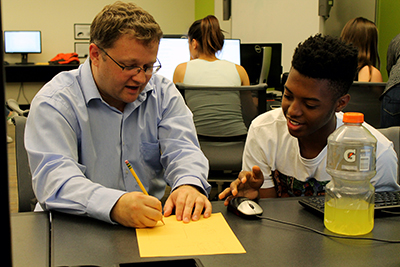
Working groups focused on ways to improve the accessibility of materials. Summaries of these discussions can be found below.
Group 1: Learning Disabilities
Here is a list of strategies and questions that arise when thinking about students with learning disabilities.
- There is value about looking at what we know about instruction for students with learning disabilities in other disciplines. In math, we start from the concrete level, then representative, then abstract; we use schema-based problem solving, and strategies for mapping out problem. Scaffolded inquiry is used in science. Paraphrasing would apply to code reading just like reading other things. How we can apply that knowledge to computing?
- Facilitate direct communication between computer science (CS) and special education (SPED) researchers, CS teachers, and SPED teachers.
- Utilize strategies from computer science collaborative learning research to support more collaboration. What makes an effective group? How do you involve students with learning disabilities (LD) in groups? Thinking about things like scripted conversations and roles.
- Seek feedback from teachers implementing these curricula.
- What can be done to improve the level of rigor in LD CS research? How to share resources?
- What strengths can we leverage that LD students bring to the table?
- How can we impact our curriculum to benefit LD students? When the classroom is online?
- How can analytics data be leveraged and what to collect?
- Bring together different curricula to step towards a universally designed one.
- We would benefit from a way to search what is out there, standardized terms and stronger scientific rigor.
Group 2: Potential Non-Visual Projects
Many ideas were formulated for non-visual projects that all students regardless of disability can enjoy.
- Music Earsketch-like project
- Create an interesting radio show
- Create interesting music composition using music mixing
- Create Poetry- Haiku
- Build interesting chat bots
- Employ additional hardware, such as Talking Tactile Tablet, that are inherently accessible
- Create audio-animations such a demonstration of tree search
- Create Lego Robotics project using the technology developed by Stephanie Ludi [1]
- Some CS Unplugged activities can be modified to be non-visual (not coding project)
- Learning some basics of text analysis is inherently non-visual. Examples include computing edit distance, frequency table, and some basic text compression. Since Grade 2 Braille is compressed, learning how that can be automated could be done as a project.
- Hands on activities with Accessible Arduino might work.
- Tangible programming might work too such as SNAP circuits, Cubetto, and Torino.
- Smartphone and tablets have built-in screen readers that could be employed in projects. Accessible development environments are needed. The sensors on smart phones and tablets such as GPS, accelerometer, gyroscope and others could lead to interesting projects.
- Other possible projects might include Dot and Dash robots
- Blind people have built accessible games that can be found on RS-Games.
[1] Stephanie Ludi Ludi, Lindsey Ellis, and Scott Jordan. 2014. An accessible robotics programming environment for visually impaired users. In Proceedings of ASSETS ‘14: International ACM SIGACCESS Conference on Computers & Accessibility. ACM, New York, NY, USA, 237-238. http://dx.doi.org/10.1145/2661334.2661385
Group 3: Accessible Classroom/Teaching
A number of ideas arose when discussing the accessible classroom and accessible teaching.
- Use accessible web-based products to structure classroom discussion and interaction.
- Teach accessibility as an important topic. The Teach Access website has a tutorial. There is also an excellent accessible web design course at the AccessComputing website.
- Universal design such as captioned video, alternative assessments, alternative explanations of concepts, clear directions, posting notes and slides, and scaffolding for assignments.
- Audio description for video.
- Statewide initiatives may be necessary to make sure the new CS course are mandated to be accessible
- Work with organizations that teach CS such as Project Lead the Way, TEALS, Teach for America, and others to help their teachers teach in an accessible way.
Group 4: Making Blocks Accessible
Block languages are currently not accessible to screen reader users. Some alternative ideas were discussed.
- Non-visual ways are needed to convey information, speech and haptics perhaps.
- Tangible blocks might be useful like in Osmo.
- Some tangible products for blind students already exist: Torino.
- Support programming without syntax errors such as in Accessible Blockly.
Group 5: Supporting skills other than coding
Computer science is not just coding. It requires the understanding of many topics. Questions posted by this group included; how can we make:
- data and data analysis accessible?
- graphs and charts accessible?
- animations and demonstrations accessible?
- basic problem solving accessible?